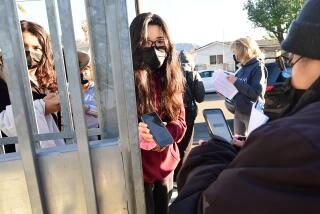San Francisco wrestles with reopening schools as it offers guidelines on doing so safely

- Share via
MENLO PARK, Calif. — Without announcing whether public schools will reopen this fall, San Francisco officials provided guidance Wednesday on how they could reopen — noting different aged children pose different risks to each other and adults.
“We’re sharing this preliminary guidance because we know schools need to plan ahead for safely resuming in-person attendance if and when the S.F. health officer allows school to open,” said Dr. C. Jeanne Lee, a pediatrician with the city’s health department.
“The good news is that we have learned a tremendous amount in the last few months about COVID-19, about how it affects children and teens and about how it’s transmitted and what’s effective at preventing the spread of COVID-19,” she said.
If schools reopen, decisions about how to best to protect students, faculty and staff — incorporating social distancing protocols, universal mask wearing, and incorporating stable student cohorts where needed — will be made independently by each school, Lee saide.
The guidelines were issued a day after Los Angeles County Public Health Director Barbara Ferrer told county superintendents they needed to prepare for students to continue learning entirely from home.
Spikes in COVID-19 cases have been seen in both counties in recent days, and the state recorded 9,500 new infections on Tuesday — the most new cases reported in a single day since the pandemic began.
Lee cautioned schools may remain closed if conditions worsen.
“If COVID-19 spreads too rapidly in our city,” she said, the guidelines issued today, “may not be enough for them to open safely.”
But, she noted, she and other medical experts have learned a lot about the disease in the last few months, and those insights could be used as schools begin preparing to re-open.
For instance, she said, “the risk is very low for school-aged students, and also evidence indicates that children, especially those under the age of 10, are less likely to be infected with COVID-19 and probably less likely to transmit it.”
Risk increases with age, however, “so for high school students, they are probably closer to adults in that risk and middle school students are probably somewhere in between.” she said.
Lee said that though social distancing is probably not an option for young children, it would be effective for older students.
And she stressed universal mask wearing for everybody in a school — from students to staff and faculty.
She said city officials focused their guidelines on preventing the transmission of disease via respiratory droplets — hence, masks and physical distancing — rather than disinfection.
She said the virus can easily be killed by most cleaning products and frequent hand washing.
Lee said the health department recommends students stay within small, stable cohorts. In elementary schools, those cohorts should be no larger than a standard classroom. In middle school and high school, she said, the cohorts could be larger, but schedules should be staggered to minimize interactions at arrivals, departures, in hallways and at meals.
She said adult-to-adult transmission brings the biggest risks.
Asked about extracurriculars, she said that generally speaking, outdoor activities carry lower risks than indoor activities, and that electives such as choir and wind instruments are not likely to be allowed. She also said that interscholastic activities would probably not be allowed.
On Wednesday, President Trump threatened to withhold funding from school systems that fail to reopen in the fall. That prompted Gov. Gavin Newsom to respond Wednesday that the reopening of schools would be based on science, not pressure from the White House.
More to Read
Sign up for Essential California
The most important California stories and recommendations in your inbox every morning.
You may occasionally receive promotional content from the Los Angeles Times.











